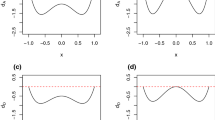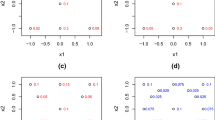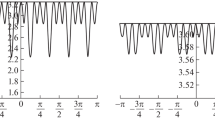Abstract
The optimal designs for Fourier regression models under the D-optimality criterion are discussed in this article. First, we investigate the D-optimal designs for estimating two coefficients corresponding to either sine or cosine terms in a full Fourier regression model. In many biological applications, estimating such specific pairs of coefficients is of interest. As a result of this article, the D-optimal designs for estimating these “coefficient pairs” can be constructed either explicitly or numerically for Fourier regression models with any order. Our resulting designs are provided for Fourier regression models with order less than 6. Secondly, we discuss the sensitivity of our resulting optimal designs for a full Fourier regression model when the true model is actually a reduced version of the assumed one. Lastly, we provide the algorithm for obtaining the D-optimal designs for a reduced Fourier regression model and the D-optimal designs for a useful reduced Fourier model are constructed. The comparison study shows that the constructed designs incorporating the reduced model are efficient.


Similar content being viewed by others
References
Bracewell RN (1986) The Fourier transform and its applications. McGraw Hill, New York
Currie AJ, Ganeshanandam S, Noition DA, Garrick D, Shelbourne CJA, Oragguzie N (2000) Quantitative evaluation of apple (Malus \(\times \) domestica Borkh.) fruit shape by principle component analysis of Fourier descriptors. Euphytica 111:219–227
Dette H, Haller G (1998) Optimal designs for the identification of the order of a Fourier regression. Ann Stat 26:1496–1521
Dette H, Melas VB (2002) E-optimal designs for Fourier regression models. Math Methods Stat 11:259–296
Dette H, Melas VB (2003) Optimal designs for estimating individual coefficients in Fourier regression models. Ann Stat 31:1669–1692
Dette H, Melas VB, Pepelyshev A (2002) D-optimal designs for trigonometric regression models on a partial circle. Ann Inst Stat Math 54(4):945–959
Dette H, Melas VB, Shpilev P (2007) Optimal designs for estimating the coefficients of the lower frequencies in trigonometric regression models. Ann Inst Stat Math 59(4):655–673
Dette H, Melas VB, Shpilev P (2009) Optimal designs for estimating pairs of coefficients in Fourier regression models. Stat Sin 19(4):1587–1601
Draper NR, Pukelsheim F (1996) An overview of design of experiments. Stat Pap 37:1–32
Fedorov VV (1972) Theory of optimal experiments. Academic, New York
Kiefer J (1961) Optimum designs in regression problems, II. Ann Math Stat 32:298–325
Melas VB, Pepelyshev A, Shpilev P, Salmaso L, Corain L, Arboretti R (2014) On the optimal choice of the number of empirical Fourier coefficients for comparison of regression curves. Stat Pap. doi:10.1007/s00362-014-0619-1
Pukelsheim F (1993) Optimal design of experiments. Wiley, New York
Rencher AC (2000) Linear models in statistics. Wiley, New York
Silvey SD (1980) Optimal design: an introduction to the theory for parameter estimation. Chapman and Hall, London
Wiens DP (1991) Designs for approximately linear regression: two optimality properties of uniform designs. Stat Probab Lett 12:217–221
Xu X, Shang X (2014) Optimal and robust designs for trigonometric regression models. Metrika 77(6):753–769
Younker JC, Ehrlich R (1977) Fourier biometrics: harmonic amplitudes as multivariate shape descriptors. Syst Zool 26:336–342
Zhang F (1999) Matrix theory: basic results and techniques. Springer, New York
Acknowledgments
The research of both authors is supported by the Natural Sciences and Engineering Research Council of Canada.
Author information
Authors and Affiliations
Corresponding author
Appendix: Proof of Lemma 1
Appendix: Proof of Lemma 1
Let \(\mathbf {x}_{\mathbf {\tau }}=(\cos ( a\tau _{1}) ,\ldots ,\cos ( a\tau _{m-1})) ^{T}.\) The following expansion
implies that as \(a\rightarrow 0,\)
then, \(\lim _{a\rightarrow 0}\mathbf {\tau }^{*}( a)\) exists and can be obtained by maximizing
over T defined in Sect. 4.2. Let \(y_{i}=\tau _{i}^{2}\in (0,\,1).\) In order to maximize the following quantity,
the conditions in (11)
must be satisfied. Similar arguments as given in Fedorov (1972) show that the polynomial \(\phi (y)=( y-y_{1})(y-y_{2}), \ldots ,( y-y_{m-1})\) satisfies the differential equation
It is well known that Eq. (12) has a unique solution given by the Jacobi polynomial \(P_{m-1}^{(1,1)}(1-2y),\) and the lemma is now proved by transformation \(y=\tau ^{2}.\) \(\square \)
Rights and permissions
About this article
Cite this article
Xu, X., Shang, X. D-optimal designs for full and reduced Fourier regression models. Stat Papers 58, 811–829 (2017). https://doi.org/10.1007/s00362-015-0727-6
Received:
Revised:
Published:
Issue Date:
DOI: https://doi.org/10.1007/s00362-015-0727-6




